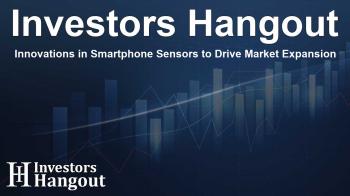Innovations in Smartphone Sensors to Drive Market Expansion

Innovations Driving Growth in the Smartphone Sensors Market
The global market for smartphone sensors is poised for remarkable growth, with estimates suggesting an increase of USD 809 million from 2025 to 2029. This growth is primarily fueled by the rising adoption of mobile augmented reality (AR) applications and the transformative impact of artificial intelligence (AI) technologies. These advancements are reshaping the sensor landscape, combining innovative technology with intricate design to enhance user experience.
Key Market Dynamics and Trends
Market Growth Drivers
One of the key factors propelling this market forward is the increasing demand for sophisticated sensor functionalities that complement new smartphone capabilities. With features like AR applications, AI integration, and advanced image stabilization becoming standard, the need for high-performance sensors such as accelerometers, gyroscopes, and optical sensors is critical. These devices not only improve user engagement but are also essential for various applications, including health monitoring and enhanced security.
Challenges Within the Market
Despite the growth potential, several challenges confront the market. Notably, the complexity of sensor design poses a substantial hurdle. As sensors become more integrated into various devices, ensuring compatibility and maintaining performance are paramount. The risk of cyber threats, such as the deployment of fake sensors, further complicates the landscape, highlighting the need for robust security measures in sensor technology.
Technological Advancements Driving Integration
Sensor fusion technology is revolutionizing the way multiple sensors within smartphones operate. By combining data from different sources, such as gyroscopes, accelerometers, and compasses, this technology enhances the accuracy of motion detection and orientation calculations. Market players like Bosch Sensortec GmbH are at the forefront, offering comprehensive solutions that optimize sensor performance through advanced algorithms.
Exploration of Market Segmentation
Price Segmentation
Market segmentation reveals distinct dynamics within different pricing tiers. The premium smartphone segment, featuring devices priced above USD 400, is notably evolving. With advanced technologies such as Human-Machine Interface (HMI) becoming mainstream, premium devices are increasingly adopting sophisticated sensors that facilitate functionalities like gesture recognition and biometric authentication.
Geographical Landscape
Regionally, the market is expanding across various continents, notably in APAC, North America, and Europe. Each region presents unique opportunities and challenges, driven by local consumer preferences and technological infrastructure. The surge in smartphone adoption, particularly in emerging markets, is accelerating the demand for advanced sensor technologies.
Consumer Behavior and Market Demands
As consumer expectations evolve, so does the landscape of smartphone technology. Users are prioritizing battery life, security, and overall user experience. Features that integrate advanced sensor capabilities are becoming a key selling point, influencing purchase decisions. The expansion of mobile networks and the introduction of 5G technology are further enhancing the functionality and demand for high-quality sensors.
Targeting Future Opportunities
Looking ahead, the smartphone sensors market is set for sustained growth, driven by innovation and an increasing focus on user safety and convenience. Manufacturers are exploring new materials to improve sensor durability and performance, while advances in AI are paving the way for even more intricate applications that can anticipate and meet user demands.
Frequently Asked Questions
What is the projected growth for smartphone sensors from 2025 to 2029?
The smartphone sensors market is estimated to grow by USD 809 million during this period, driven by growing AR and AI applications.
What are the main technologies driving market growth?
Key technologies include augmented reality applications and artificial intelligence, which enhance the capabilities of smartphone sensors.
What challenges does the smartphone sensors market face?
Challenges include design complexity, compatibility with existing devices, and security risks related to sensor integrity.
How does sensor fusion technology benefit smartphones?
Sensor fusion technology enhances the accuracy of motion detection and orientation, crucial for applications like AR and navigation.
What impact does consumer behavior have on the market?
Consumer preferences for quality, security, and innovative features significantly influence the demand and development of smartphone sensors.
About Investors Hangout
Investors Hangout is a leading online stock forum for financial discussion and learning, offering a wide range of free tools and resources. It draws in traders of all levels, who exchange market knowledge, investigate trading tactics, and keep an eye on industry developments in real time. Featuring financial articles, stock message boards, quotes, charts, company profiles, and live news updates. Through cooperative learning and a wealth of informational resources, it helps users from novices creating their first portfolios to experts honing their techniques. Join Investors Hangout today: https://investorshangout.com/
Disclaimer: The content of this article is solely for general informational purposes only; it does not represent legal, financial, or investment advice. Investors Hangout does not offer financial advice; the author is not a licensed financial advisor. Consult a qualified advisor before making any financial or investment decisions based on this article. The author's interpretation of publicly available data shapes the opinions presented here; as a result, they should not be taken as advice to purchase, sell, or hold any securities mentioned or any other investments. The author does not guarantee the accuracy, completeness, or timeliness of any material, providing it "as is." Information and market conditions may change; past performance is not indicative of future outcomes. If any of the material offered here is inaccurate, please contact us for corrections.
